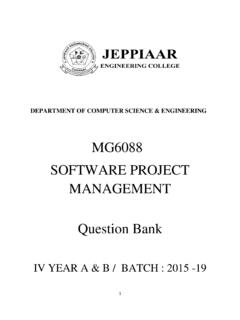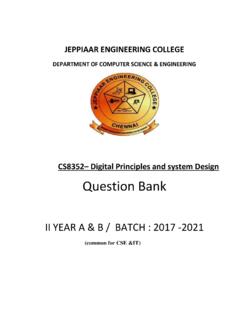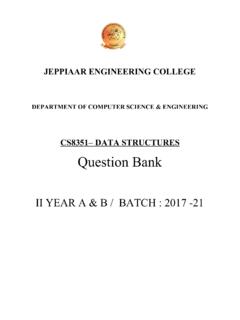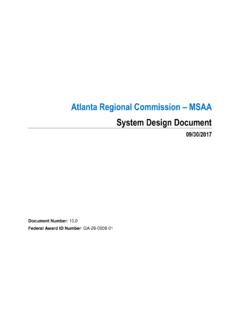Transcription of CS8493 OPERATING SYSTEMS Question Bank - Jeppiaar
1 DEPARTMENT OF COMPUTER SCIENCE AND. ENGINEERING. CS8493 OPERATING SYSTEMS . Question bank II YEAR A & B / BATCH : 2017 -21. Vision of Institution To build Jeppiaar Engineering College as an Institution of Academic Excellence in Technical education and Management education and to become a World Class University. Mission of Institution M1 To excel in teaching and learning, research and innovation by promoting the principles of scientific analysis and creative thinking To participate in the production, development and dissemination of knowledge and M2. interact with national and international communities To equip students with values, ethics and life skills needed to enrich their lives and M3. enable them to meaningfully contribute to the progress of society M4 To prepare students for higher studies and lifelong learning, enrich them with the practical and entrepreneurial skills necessary to excel as future professionals and contribute to Nation's economy Program Outcomes (POs).
2 Engineering Knowledge: Apply the Knowledge of mathematics, science, PO1 engineering fundamentals, and an engineering specialization to the solution of complex engineering problems. Problem analysis: Identify, formulate, review research literature, and analyze PO2 complex engineering problems reaching substantiated conclusions using first principles of mathematics, natural sciences, and engineering sciences. Design/development of solutions: Design solutions for complex engineering problems and design system components or processes that meet the specified PO3. needs with appropriate consideration for the public health and safety, and the cultural, societal, and environmental considerations Conduct investigations of complex problems: Use research-based Knowledge PO4 and research methods including design of experiments, analysis and interpretation of data, and synthesis of the information to provide valid conclusions.
3 Modern tool usage: Create, select, and apply appropriate techniques, resources, PO5 and modern engineering and IT tools including prediction and modeling to complex engineering activities with an understanding of the limitations. The engineer and society: Apply reasoning informed by the contextual PO6 Knowledge to assess societal, health, safety, legal and cultural issues and the consequent responsibilities relevant to the professional engineering practice. Environment and sustainability: Understand the impact of the professional PO7 engineering solutions in societal and environmental contexts, and demonstrate the Knowledge of, and need for sustainable development. Ethics: Apply ethical principles and commit to professional ethics and PO8. responsibilities and norms of the engineering practice. Individual and team work: Function effectively as an individual, and as a PO9. member or leader in diverse teams, and in multidisciplinary settings.
4 Communication: Communicate effectively on complex engineering activities with the engineering community and with society at large, such as, being able to PO10. comprehend and write effective reports and design documentation, make effective presentations, and give and receive clear instructions. Project management and finance: Demonstrate Knowledge and understanding of the engineering and management principles and apply these to one's own work, PO11. as a member and leader in a team, to manage projects and in multidisciplinary environments. Life-long learning: Recognize the need for, and have the preparation and ability PO12 to engage in independent and life-long learning in the broadest context of technological change. Vision of Department To emerge as a globally prominent department, developing ethical computer professionals, innovators and entrepreneurs with academic excellence through quality education and research.
5 Mission of Department To create computer professionals with an ability to identify and formulate the M1. engineering problems and also to provide innovative solutions through effective teaching learning process. M2 To strengthen the core-competence in computer science and engineering and to create an ability to interact effectively with industries. M3 To produce engineers with good professional sKills, ethical values and life skills for the betterment of the society. M4 To encourage students towards continuous and higher level learning on technological advancements and provide a platform for employment and self-employment. Program Educational Objectives (PEOs). PEO1 To address the real time complex engineering problems using innovative approach with strong core computing skills. PEO2 To apply core-analytical Knowledge and appropriate techniques and provide solutions to real time challenges of national and global society PEO3 Apply ethical Knowledge for professional excellence and leadership for the betterment of the society.
6 PEO4 Develop life-long learning skills needed for better employment and entrepreneurship CS8493 OPERATING SYSTEMS . LTPC 3003. OBJECTIVES: To understand the basic concepts and functions of OPERATING SYSTEMS . To understand Processes and Threads To analyze Scheduling algorithms. To understand the concept of Deadlocks. To analyze various memory management schemes. To understand I/O management and File SYSTEMS . To be familiar with the basics of Linux system and Mobile OS like iOS and Android. UNIT I OPERATING system OVERVIEW 7. Computer system Overview-Basic Elements, Instruction Execution, Interrupts, Memory Hierarchy, Cache Memory, Direct Memory Access, Multiprocessor and Multicore Organization. OPERATING system overview-objectives and functions, Evolution of OPERATING Computer system Organization OPERATING system Structure and Operations- system Calls, system Programs, OS Generation and system Boot. UNIT II PROCESS MANAGEMENT 11.
7 Processes Process Concept, Process Scheduling, Operations on Processes, Inter-process Communication; CPU Scheduling Scheduling criteria, Scheduling algorithms, Multiple- processor scheduling, Real time scheduling; Threads- Overview, Multithreading models, Threading issues; Process Synchronization The critical-section problem, Synchronization hardware, Mutex locks, Semaphores, Classic problems of synchronization, Critical regions, Monitors; Deadlock system model, Deadlock characterization, Methods for handling deadlocks, Deadlock prevention, Deadlock avoidance, Deadlock detection, Recovery from deadlock. UNIT III STORAGE MANAGEMENT 9. Main Memory Background, Swapping, Contiguous Memory Allocation, Paging, Segmentation, Segmentation with paging, 32 and 64 bit architecture Examples; Virtual Memory Background, Demand Paging, Page Replacement, Allocation, Thrashing; Allocating Kernel Memory, OS. Examples. UNIT IV FILE SYSTEMS AND I/O SYSTEMS 9.
8 Mass Storage system Overview of Mass Storage Structure, Disk Structure, Disk Scheduling and Management, swap space management; File- system Interface File concept, Access methods, Directory Structure, Directory organization, File system mounting, File Sharing and Protection; File system Implementation- File system Structure, Directory implementation, Allocation Methods, Free Space Management, Efficiency and Performance, Recovery; I/O. SYSTEMS I/O Hardware, Application I/O interface, Kernel I/O subsystem, Streams, Performance. UNIT V CASE STUDY 9. Linux system Design Principles, Kernel Modules, Process Management, Scheduling, Memory Management, Input-Output Management, File system , Inter-process Communication; Mobile OS iOS and Android Architecture and SDK Framework, Media Layer, Services Layer, Core OS Layer, File system . TOTAL : 45 PERIODS. TEXT BOOK : 1. Abraham Silberschatz, Peter Baer Galvin and Greg Gagne, OPERATING system Concepts , 9th Edition, John Wiley and Sons Inc.
9 , 2012. Course Outcomes (COs). Analyze various scheduling algorithms. Understand deadlock, prevention and avoidance algorithms. Compare and contrast various memory management schemes. Understand the functionality of file SYSTEMS . Perform administrative tasks on Linux Servers. Compare iOS and Android OPERATING SYSTEMS . BLOOM TAXANOMY LEVELS. BTL1: Remembering., BTL2: Evaluating., BTL3: Analyzing., BTL4: Applying., BTL5: Understanding., BTL6: Creating INDEX. UNIT NO TEXT/ REFERENCE BOOK PAGE. NO. UNIT -I Abraham Silberschatz, Peter Baer Galvin and Greg Gagne, OPERATING system Concepts , 9th Edition, John Wiley and Sons 4-98. Inc., 2012. UNIT -II Abraham Silberschatz, Peter Baer Galvin and Greg Gagne, OPERATING system Concepts , 9th Edition, John Wiley and Sons 103-422. Inc., 2012. UNIT -III Abraham Silberschatz, Peter Baer Galvin and Greg Gagne, OPERATING system Concepts , 9th Edition, John Wiley and Sons 455-572. Inc.
10 , 2012. UNIT -IV Abraham Silberschatz, Peter Baer Galvin and Greg Gagne, OPERATING system Concepts , 9th Edition, John Wiley and Sons 575-688. Inc., 2012. UNIT -V Abraham Silberschatz, Peter Baer Galvin and Greg Gagne, OPERATING system Concepts , 9th Edition, John Wiley and Sons 695-795. Inc., 2012. UNIT I. OPERATING SYSTEMS OVERVIEW. Computer system Overview-Basic Elements, Instruction Execution, Interrupts, Memory Hierarchy, Cache Memory, Direct Memory Access, Multiprocessor and Multicore Organization. OPERATING system overview-objectives and functions, Evolution of OPERATING Computer system Organization- OPERATING system Structure and Operations- system Calls, system Programs, OS Generation and system Boot. PART A. Blooms S. Question CO Taxanomy No. Level 1 What are the objectives of OPERATING system ? (AU: April/May 2010) (AU: May/June 2012). (April/May 2017). Ans: An OPERATING system is a program that BTL-1. manages the computer hardware.






